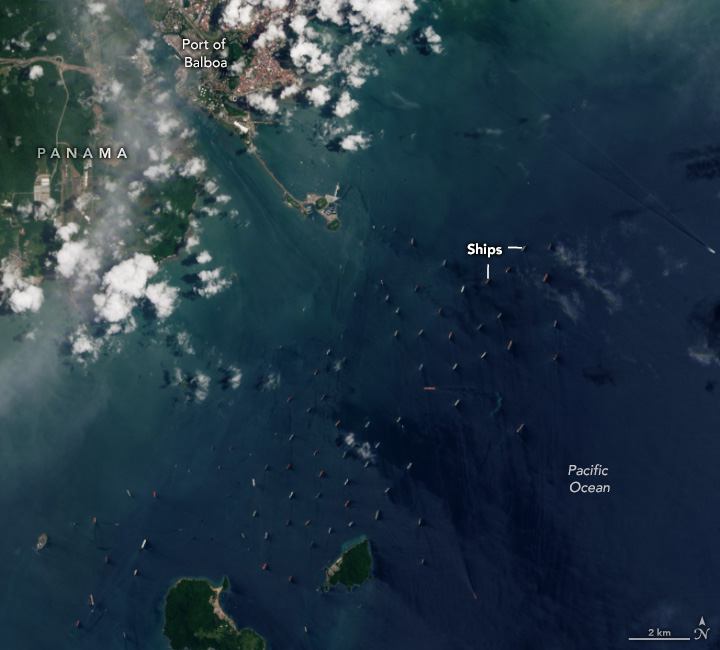
Panama Canal Traffic Backup
Downloads
- panamatraffic_oli_2023230_lrg.jpg (784x708, JPEG)
Metadata
- Sensor(s):
- Data Date: August 18, 2023
- Visualization Date: August 31, 2023
While some weather-related delays are mere annoyances, others slow the rhythms of global shipping. Due to ongoing drought and low water levels, ship traffic was restricted through the Panama Canal in late summer 2023, leaving an above-average number of vessels waiting to make the transit.
The Panama Canal is an 80-kilometer (50-mile) artificial waterway across the Isthmus of Panama, providing a vital connection between the Atlantic and Pacific Oceans for up to 14,000 ships each year. The Operational Land Imager (OLI) on Landsat 8 got a rare cloud-free view of delayed ships on the Pacific side of the canal on August 18, 2023.
Artificial lakes supply the water needed to fill the series of locks in the canal. Those lakes, located to the north and northwest of this scene, are replenished by rainfall that is typically in abundance on the Isthmus of Panama. However, drought has left Lago Gatún, the largest lake feeding the system, at near-record low levels. In mid-August, it stood close to the lowest recorded level, from May 2016, and well below the average level for August from the past five years.
As a means of conserving water, the Panama Canal Authority reduced the number of vessels that could travel through the canal each day starting on July 30. At one point in early August, the ensuing backup reached as high as 160 total vessels waiting on one side or the other. By the time of this image, that number had decreased to around 130, whereas the queue ordinarily tops off around 90. The average wait time for August 2023 was nearly four times what it was in June.
The reduction of daily passages was the latest restriction imposed by the Panama Canal Authority this year to deal with the water shortages. Starting on March 1, 2023, it began reducing the maximum draft (the distance between the waterline and the bottom of the hull) permitted for vessels passing through the locks. The normal limit of 50 feet (15 meters) for the largest class of ships that use the canal was increasingly ratcheted down to 44 feet (13 meters), requiring some ships to lighten their loads.
The area has seen a number of dry years in the past decade; Lago Gatún dipped to low levels in 2016 and 2019, in addition to 2023. At the other extreme, however, Lago Gatún and Lago Alajuela, another lake feeding the canal, reached record high levels in December 2010. The flooding caused the canal to close for only the third time in its history.
References
- NASA Earth Observatory (2010, Dec 21) Lago Alajuela, Panama. Accessed August 31, 2023.
- Panama Canal Authority (2023) Advisory to Shipping. Accessed August 31, 2023.
- Panama Canal Authority (2023) Gatun Water Level Indicators. Accessed August 31, 2023.
- Reuters (2023, August 21) Focus: Historic drought, hot seas slow Panama Canal shipping. Accessed August 31, 2023.
NASA Earth Observatory image by Wanmei Liang, using Landsat data from the U.S. Geological Survey. Story by Lindsey Doermann.
This image record originally appeared on the Earth Observatory. Click here to view the full, original record.